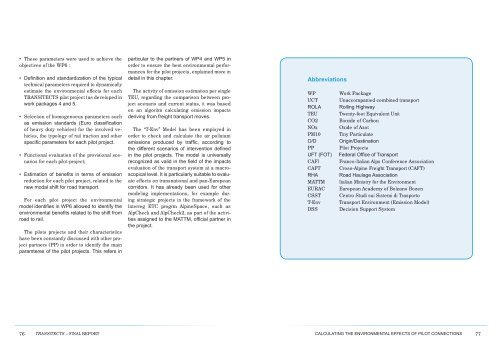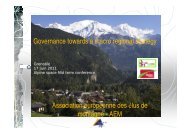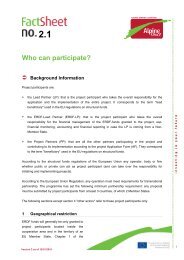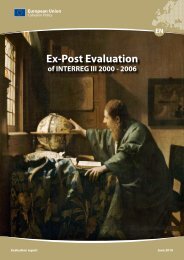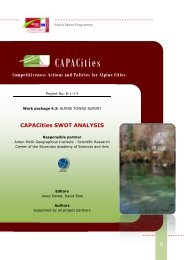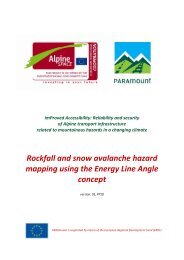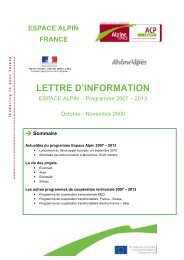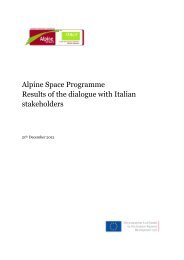intermodal solutions for transalpine freight traffic - Alpine Space ...
intermodal solutions for transalpine freight traffic - Alpine Space ...
intermodal solutions for transalpine freight traffic - Alpine Space ...
You also want an ePaper? Increase the reach of your titles
YUMPU automatically turns print PDFs into web optimized ePapers that Google loves.
• These parameters were used to achieve the<br />
objectives of the WP6 :<br />
• Definition and standardization of the typical<br />
technical parameters required to dynamically<br />
estimate the environmental effects <strong>for</strong> each<br />
TRANSITECTS pilot project (as developed in<br />
work packages 4 and 5.<br />
• Selection of homogenoeus parameters such<br />
as emission standards (Euro classification<br />
of heavy duty vehicles) <strong>for</strong> the involved vehicles,<br />
the typology of rail traction and other<br />
specific parameters <strong>for</strong> each pilot project.<br />
• Functional evaluation of the provisional scenarios<br />
<strong>for</strong> each pilot-project;<br />
• Estimation of benefits in terms of emission<br />
reduction <strong>for</strong> each pilot project, related to the<br />
new modal shift <strong>for</strong> road transport.<br />
For each pilot project the environmental<br />
model identifies in WP6 allowed to identify the<br />
environmental benefits related to the shift from<br />
road to rail.<br />
The pilots projects and their characteristics<br />
have been constantly discussed with other project<br />
partners (PP) in order to identify the main<br />
paramteres of the pilot projects. This refers in<br />
particular to the partners of WP4 and WP5 in<br />
order to ensure the best environmental per<strong>for</strong>mances<br />
<strong>for</strong> the pilot projects, explained more in<br />
detail in this chapter.<br />
The activity of emission estimation per single<br />
TEU, regarding the comparison between project<br />
scenario and current status, it was based<br />
on an algoritm calculating emission impacts<br />
deriving from <strong>freight</strong> transport moves.<br />
The “T-Env” Model has been employed in<br />
order to check and calculate the air pollutant<br />
emissions produced by <strong>traffic</strong>, according to<br />
the different scenarios of intervention defined<br />
in the pilot projects. The model is universally<br />
recognized as valid in the field of the impacts<br />
evaluation of the transport system at a macroscopical<br />
level. It is particularly suitable to evaluate<br />
effects on transnational and pan-European<br />
corridors. It has already been used <strong>for</strong> other<br />
modeling implementations, <strong>for</strong> example during<br />
strategic projects in the framework of the<br />
Interreg ETC progrm <strong>Alpine</strong><strong>Space</strong>, such as<br />
AlpCheck and AlpCheck2, as part of the activities<br />
assigned to the MATTM, official partner in<br />
the project.<br />
abbreviations<br />
WP Work Package<br />
UCT Unaccompanied combined transport<br />
ROLA Rolling Highway<br />
TEU Twenty-foot Equivalent Unit<br />
CO2 Bioxide of Carbon<br />
NOx Oxide of Azot<br />
PM10 Tiny Particulate<br />
O/D Origin/Destination<br />
PP<br />
Pilot Projects<br />
UFT (FOT) Federal Office of Transport<br />
CAFI Franco-Italian Alps Conference Association<br />
CAFT Cross-<strong>Alpine</strong> Freight Transport (CAFT)<br />
RHA Road Haulage Association<br />
MATTM Italian Ministry <strong>for</strong> the Environment<br />
EURAC European Academy of Bolzano Bozen<br />
CSST Centro Studi sui Sistemi di Trasporto<br />
T-Env Transport Environment (Emission Model)<br />
DSS Decision Support System<br />
76 transitects – final report<br />
CALCULATING THE ENVIRONMENTAL EFFECTS OF PILOT CONNECTIONS<br />
77


